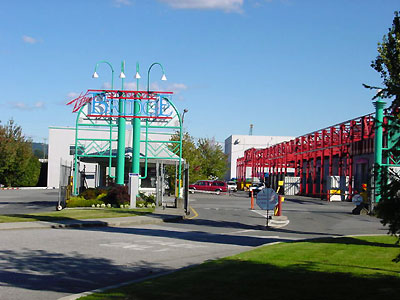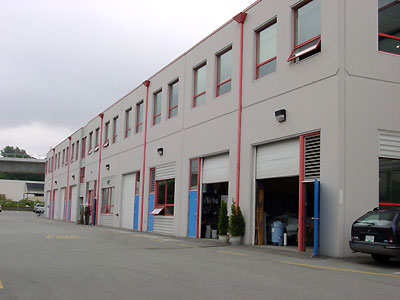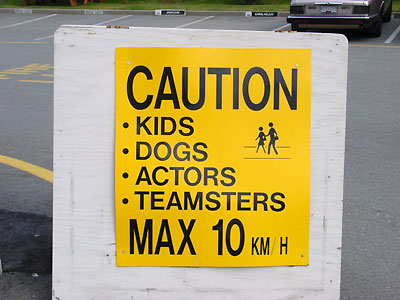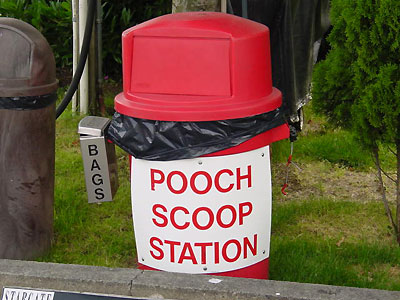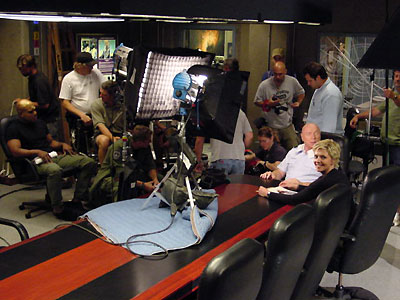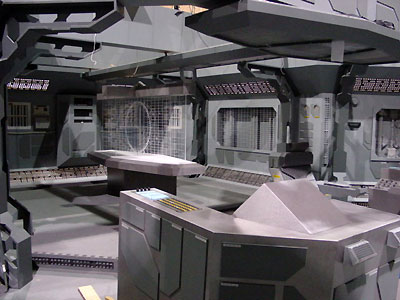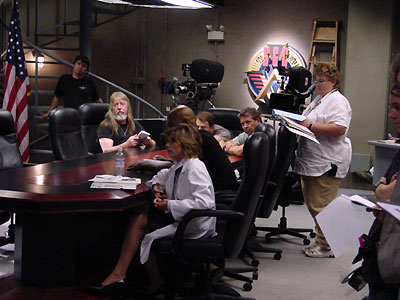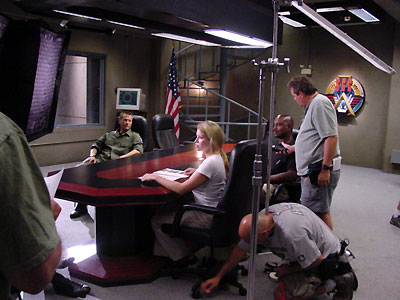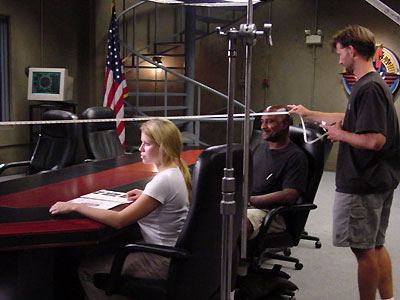ON THE SET - DAY ONE
Behind the Scenes of "Smoke & Mirrors": The Briefing Room
If you were to look up the word "teamwork" in any reliable dictionary, you shouldn't be surprised if you were to see a picture of the people behind Stargate SG-1 displayed prominently on the page. The massive undertaking that is the production of each weekly episode is a testament to the professionalism and cooperation of the hundreds of people behind the scenes. It has been mentioned before in numerous interviews that the Stargate production is like a well-oiled machine, but there is nothing "mechanical" about the atmosphere on the set. These people have far too much fun.
The Explorer Unit Team Briefing was invited to visit the set of Stargate SG-1 to investigate the many aspects that go into the making of an episode. Over the coming months, the Team Briefings will include a series of articles that will take a look at the goings-on behind the scenes and will cover the contributions of major departments as well as interviews with cast, crew, and producers. Our visit took place in mid July as SG-1 returned to production after a three-week summer hiatus. On Monday morning, shooting was ready to begin on Smoke and Mirrors, episode #14 of the sixth season. Meanwhile, upstairs in the production offices, preparations were already under way for the fifteenth episode, Paradise Lost. Producing a television series is a delicately balanced juggling act, with various stages from pre-production to post-production all happening simultaneously. Many of these stages will be explored during this glimpse inside the world of Stargate SG-1.
The universe of Stargate SG-1 is brought to life at the Bridge Studios in Burnaby, a suburb of Vancouver, British Columbia. Viewers will recognize the setting as the Hollywood studio where Martin Lloyd's Wormhole X-treme! was filmed. Several productions, both television and features, are made here, but Stages 5 and 6 are home to the Tauri, their enemies and allies, and the stargate that connects them. Walking onto the lot, the nature of the working environment becomes immediately apparent. A bold yellow street sign displaying the universal symbol for children crossing, urges visitors to proceed slowly, with the warning, "CAUTION: Kids, Dogs, Actors, Teamsters, MAX 10km/h." Nearby, another sign attests to the fact that the second name on that list is indeed a significant presence on the set. Dogs accompany their owners to work and wander freely within the production offices, and necessary accommodations are made at a bright red receptacle in the parking lot labeled "Pooch Scoop Station."
In fact, the family atmosphere of the place is evident. Speak to anyone connected with the production and you're likely to hear what a great place it is to work. Monday morning finds the cast, crew, and production team returning to the studio after their mid-season hiatus as principal photography begins for the episode Smoke and Mirrors. Written by Joseph Mallozzi and Paul Mullie from a story by Katharyn Powers, the episode deals with a political assassination for which Colonel O'Neill has been arrested, and the investigation by his team to clear his name. The first day back is a relatively easy one involving scenes at the SGC, shot at the permanent set on Stage 5. Richard Dean Anderson's vacation has been extended for a day, and he's not due to return until tomorrow. However Amanda Tapping, Christopher Judge, Corin Nemec, and Don S. Davis gather upstairs in the briefing room, with Peter DeLuise at the helm as director, to discuss the evidence against the colonel.
The briefing room is crowded as the cast and crew prepare to shoot scene 8. The scene is a relatively uncomplicated one. Carter is briefing Teal'c, Jonas, and Hammond on her analysis of a videotape which clearly incriminates Colonel O'Neill. They are seated around the table, however for this angle the cameras will be focusing only on Hammond and Carter, leaving Christopher Judge and Corin Nemec seated off to the side to deliver their lines from off-camera for the time being. Two cameras, designated Camera A and Camera B, are placed in position for close-ups, and the focus puller measures the distance to each actor with a long measuring tape. The lights are placed in position, the mikes set up, Carter's folder is supplied by the props department, costumes are checked for continuity from the previous scene, and the director calls for rehearsal.
SG-1 makes use of a video monitoring system dubbed the "video village," consisting of a rolling cart with double monitors and VCRs that are linked to the cameras. For each take, the images from the cameras, one from Camera A and one from Camera B, can be monitored simultaneously from the "village." Today the monitors are set up in the hallway leading past Hammond's office, out of the way of the activity in the briefing room. Normally the director, producer, and script supervisor observe the scenes from this vantage point, and the hallway is bustling with other crew members watching out of the view of the camera. With rehearsal complete, the director calls for "finals," and the hair, makeup, and costume departments jump into action for final touch-ups before the cameras roll.
The scene must be shot several times, using different camera angles and close-ups each time which will then be put together during the editing process. With the call for "Action," filming begins. The team is entirely professional, but even professionalism doesn't prevent the unexpected, and numerous retakes are required as interruptions intervene. One of the lines is missed, and from the hallway the script supervisor feeds the scripted words. The camera is picking up the reflection of one of the crew in the glass windows, and must be reset. One of the actors misses the cue to redirect his attention with the dialogue, and must be reminded. As Christopher Judge prepares to deliver his line, someone enters the soundstage from down below, and his footsteps and whistling carry upstairs, prompting Christopher, without missing a beat, to retort instead, "Perhaps the sound from downstairs would provide the answers." At last everything is in place for the final take, and as "Action" is called once again, the camera runs out of film, and shooting is paused once more to make the change. "Is this the first day back?" quips Don Davis, at the interruptions conspiring to sabotage what should be a simple scene.
Yet through the numerous retakes, there is no hint of frustration. The mood remains light, and there are jokes and laughter. Peter DeLuise is the epitome of patience, calmly marking where to return in the script to begin the scene again, or pointing out a reminder of a missed cue. It is a directing style for which he is known, that only when things are going well does he slip into the persona of his alter ego from Wormhole X-treme!, raising his voice in mock outrage, and bringing the entire production to fits of stifled laughter. During this scene in the briefing room, projection equipment has been set up in Hammond's office that will be used later for rear projection against the screen between the two rooms, and to prevent ambient light, a black curtain covers the doorway from the office to the hall. The playback is controlled from downstairs, and as DeLuise seats himself at the video village in the hallway and calls for the next scene to begin, the young man responsible for the playback darts from behind the black curtain, through the briefing room, and makes a dash for the lower level. In a perfect imitation of his Wormhole X-treme! counterpart, DeLuise bellows after him, "Run, you blond freak!" causing everyone to break into laughter, and then to struggle desperately to regain their composure when "Action" is immediately called. Such minor interruptions aren't unusual, however, and are taken in stride, and in good fun. The scene is successfully completed before the lunch hour, and everyone vanishes in the direction of the catering truck.
The lunch break provides an ideal opportunity for a tour of the facility. The permanent sets of the SGC are housed on Stage 5, and are indeed built on two different levels, just as they appear on the screen. The gateroom (or "embarkation room") houses the stargate, and is more than two stories tall. The rear wall is removable and can be rolled out of the way, revealing a green screen to be used for special visual effects such as the event horizon. At the opposite end, behind glass windows, is the control room housing the computer terminals and monitors that control the gate. Someone with a mischievous imagination has had some fun with the terminals, none of which displays a standard QWERTY keyboard. Instead, the keys have been rearranged in a variety of subliminal messages such as "Help" or "Cozy Pig." Two stairways lead to the briefing room on the second level, the spiral stairway in the corner continuing on to nothing on the level above. Adjacent to the briefing room is General Hammond's office, decorated in minute detail with the insignia and mementos of his career. Everything in the office has the feel of complete authenticity with the exception of the familiar red phone on the desk, which curiously is made of wood. The hallway beyond the general's office extends to nothingness, as a plain wooden stairway leads back to the lower level.
Exiting the stargate, and continuing through the doorway to the right of the gateroom leads to the tunnel hallways. However, immediately beyond the doorway, there is an open space before the tunnel begins. Through the magic of set decoration, this space has been used for any number of recurring sets, from the commissary to a holding cell to Teal'c's quarters. The tunnel hallways form a "T", and the lighting along the walls can accommodate colored gels to give the impression that similar hallways on different levels are being used. The tunnel to the left leads to the elevators, small spaces with removable rear walls to accommodate the camera. Directly ahead, the tunnel leads to another empty space. Most often it is used as the infirmary, however it has also appeared as Fraser's office, and any number of guest quarters and supply rooms. A hallway to the right of the infirmary leads to yet another multi-purpose room. Carter's lab, Daniel's office, Jonas's office, and the observation theater are all shot on the same set. The windows of the observation theater can be removed and covered when they are not needed, and skillful set decorators can quickly transform the room into whatever is needed for the day's shoot. Other items not currently being used can be found stored in corridors and alcoves, a MALP here, a UAV there, the iris, extra doors, a hospital bed. It is easy to lose your bearings, wandering around the hallways, and just as easy to understand how creative camera angles can give the impression that the SGC, 28 floors below ground, is really a much larger structure than the set itself. The entire set of the facility looks and feels so realistic that it is quite disconcerting to continue down a hallway and be greeted by empty spaces and construction materials where the illusion abruptly ends.
Next door, on Stage 6, are other recurring sets and alien worlds. For some time, the Go'auld mothership had been housed here during its appearance in numerous episodes. Now the mothership has been replaced by another recurring set. This is home to the X-303. The X-303, the first true interstellar ship built on Earth, was created for the episode Prometheus. However, the set is so enormous that it had to be written into more than one episode in order to justify the expense to build it. The bridge, the corridors, and adjoining rooms within the vast ship now fill much of the sound stage, and the detail is exquisite. However, even though the episode was filmed some weeks earlier, it is apparent that certain parts of the set are incomplete. Terminals are missing, wires protrude from the walls, and spaces lead to nowhere. The explanation is a simple one. The set had taken longer to construct than anticipated, and when shooting began for Prometheus, the X-303 set was not quite complete. The solution? The script was altered so that the ship would be hijacked before its completion, allowing the story to unfold on an unfinished set.
Following the lunch hour, the cast and crew return for the afternoon's shoot. Carter won't be needed for the remaining scenes, so Amanda Tapping has taken advantage of the early afternoon and has left for the day. Christopher Judge, Corin Nemec, and Don Davis are joined by Teryl Rothery, and they gather in the briefing room for scene 18, in which Jonas presents the results of an investigation, and Dr. Fraser shares her medical findings. The scene requires the use of the big screen which can be dropped down over the window of the stargate map between the briefing room and Hammond's office. The effect is achieved by removing the window and replacing it with the screen which will display the images from a rear projector set up in Hammond's office. A similar effect could be achieved in post production, but updated technology and an old technique provide an option that is far less expensive. Unlike television, LCD projectors use a consistent light, and don't need to be phased, or synchronized, in order to avoid distorted lines when filming the image. Jim Menard, director of photography, had developed this economical strategy to be used in the many scenes in which projected images are used during briefings.
The afternoon's scenes go smoothly. First is the blocking, in which the director walks the actors through the scene to establish where they will sit, stand, or move. Members of the crew seat themselves at the table and around the room as the director outlines where the cameras and lights and sound will be set. The lines are rehearsed and the actions established under the watchful eye of the script supervisor who is responsible for the continuity of the scene. As the camera angles are established, the focus is adjusted, and the sound and lighting are put in place, stand-ins take the place of the actors. A stand-in fills in for an actor while a scene is being set, but does not appear on camera, as opposed to a double who must resemble the actor he replaces, and who appears on camera for certain scenes. Today Alaina has been the stand-in for both Amanda Tapping and Teryl Rothery, and viewers will recognize Christopher Judge's stand-in, Herbert Duncanson, as Grell the Robot from "Wormhole X-treme!." Once the equipment is set, the actors' marks are indicated on the floor with colored tape, and the costume set supervisor and the assistant prop master use their collection of Polaroid shots to check the continuity with previous scenes. The actors return for "finals," as hair and makeup are touched up for camera, and the filming begins.
The scene is shot numerous times in order to allow for every possible camera angle. Both Camera A and Camera B are used, their images being displayed on the two monitors of video village with each take. Corin stands in front of the projection screen, using a remote to change the images as he speaks. One camera focuses on him, while the other includes the other three actors around the table. A double shot of Teal'c and Frasier is completed next, then single shots of each individual actor. To ensure that each of these takes will blend together seamlessly during the editing process, it is vital that the lines and movements match exactly each time the scene is repeated. The actors carefully duplicate their movements, and it is the job of the script supervisor, seated in the hallway by the video village, to confirm that Corin's hand movements are repeated, that Don turns in his chair at the same angle, and that Teryl closes her folder at precisely the same moment for each take. The crew that is not needed during the shooting gathers in the hallway, watching quietly, or whispering between takes. Ronny Cox, who is a guest star in the episode, had dropped off a copy of his latest CD, and several people pause to examine it on the cart near the monitors. Occasionally a tray of snacks or fresh fruit is brought by for afternoon appetites. By 3:30 the scene is completed, and only one scene remains for the day. Scene 24 involves only Don Davis, so very grateful actors and some unneeded crew make their early exit.
The final scene takes place in Hammond's office, and so the projector is removed, and furniture rearranged to clear the room in preparation. The cameras, lights, and sound are positioned, and rehearsal begins. General Hammond is speaking on the phone to Major Carter, and scenes with Amanda Tapping will later be inter-cut during editing. For today, the script supervisor feeds Carter's lines to Don as he completes his half of the conversation. From off camera comes Carter's line, "I'll keep you posted, Sir," and the scene ends. "That woman never says goodbye!" laments Don at the abruptly ended conversation. Final preparations are made, and the scene is completed in barely half an hour.
It is 4:00pm, and the shooting has wrapped. Peter DeLuise has a reputation for extraordinary efficiency, and is well known, and admired, for being able to wrap early. Delighted crew members, used to 12 and 14-hour days, comment that it feels just like the first day of school, back from a summer vacation, and able to go home early. As if by magic, the equipment is cleared away, and everyone prepares to leave for the day. Tomorrow is another early call. After all, at 7am there will be an assassination at the hotel across the street.
____________________
Ritter, Kate. "On the Set - Day One." July 15, 2002.

